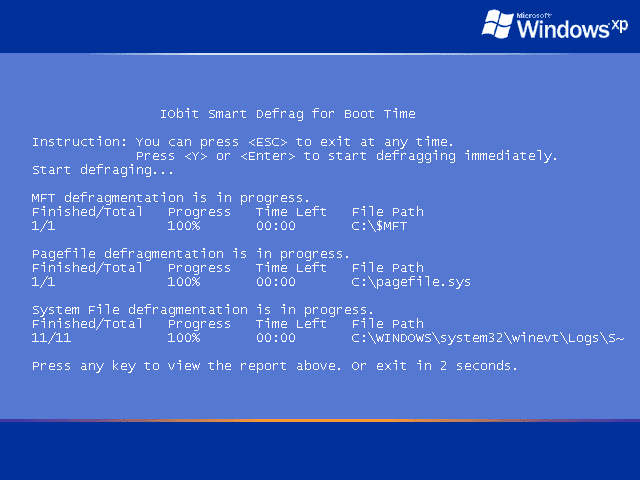Windows Vista Defragmenter Process
29 juin 2017Microsoft Defragmenter Download Windows 7
What is new in the Disk Defragmenter from Windows Vista SP1. If I run defrag from a command prompt I will then find the defrag process in the task manager process. What Is Disk Defragmentation? Do I Really Need. Windows 10, macOS, etc.
/about/1a-opendefragprogram-56aa11c23df78cf772ac3ebf.jpg)

How do I prevent the Windows Disk Defragmenter tool (dfrgntfs.exe) from automatically launching when my Windows Vista machine is idle? I defrag my hard drive with. 7829 views Does Vista display a graphic representation of the disk defragment process like XP does? How to defragment your hard drive in Windows 7 with step-by-step instructions and visual illustrations. Disk Defragmenter is a utility in Microsoft Windows designed to increase access speed by rearranging files stored on a disk to occupy contiguous storage locations, a. Learn about Disk Defragmenter in Windows 10/8/7 features, use Disk defragmenter using Command line options, fix if Disk defragmenter does not run, etc. With Windows Server 2008 R2, Windows Server 2008, and, Windows Vista, you can schedule to defragment a volume. To interrupt the defragmentation process.
Defragmenting Files (Windows)When a file is written to a disk, sometimes the file cannot be written in contiguous clusters. Noncontiguous. clusters slow down the process of reading and writing a file.
2 If necessary, click Defragment Now. A message appears that Windows is defragmenting your drive and that it may take up to a few hours to complete. Defragmenting a Hard Drive in Windows 7. Defragmenting a hard drive with Windows 7 is. With Windows Vista, Microsoft automated the defrag process but.
Windows Defragmenter Windows 10
The further apart on a disk the noncontiguous. To optimize files for fast access, a. Defragmentation is the process of moving portions of files around on a disk. However, in a multitasking operating system, some processes. Solving this problem is not trivial, but it is possible.

To allow defragmentation without requiring detailed knowledge of a file system disk structure, a set of three. The control codes provide the following functionality. Enable applications to locate empty clusters. Determine the disk location of file clusters. Move clusters on a disk. The control codes also transparently handle the problem of inhibiting and allowing other processes to read.
These operations can be performed without inhibiting other processes from running. However, the other processes.
To defragment a file. Use the FSCTL. Ideally, there is enough. Use the FSCTL. Only. An application. should check the rights of a user who attempts to run defragmentation software, and it should not allow a user to. When using Create.
File to open a directory during. FAT or FAT3. 2 file system volume, specify the GENERIC. Do not specify the MAXIMUM. Access to the. directory is denied if that is done. Do not attempt to move allocated clusters in an NTFS file system. Re- parse points, bitmaps, and attribute lists in NTFS file system volumes can be defragmented, opened for. INDEX. This reduces.

The move request block size is less than or equal to 1. KB. The move delta is not in increments of 1. KB. The move delta is the number of bytes between the start of the source block and the start of the target block.
So, assuming 4- KB clusters, a move from cluster 3 to cluster 2. Below is the list of files, streams, and stream types (also called attribute.
FSCTL. MFT: :$DATA$MFT: :$ATTRIBUTE.


Disk Defragmenter (Windows) - Wikipedia. Disk Defragmenter is a utility in Microsoft Windows designed to increase access speed by rearranging files stored on a disk to occupy contiguous storage locations, a technique called defragmentation. Defragmenting a disk minimizes head travel, which reduces the time it takes to read files from and write files to the disk. Microsoft's MS- DOS did not defragment hard disks. Several third party software developers marketed defragmenters to fill this gap. MS- DOS 6. 0 introduced Defrag. Windows NT, however, did not offer a Defrag utility, and Symantec was suggested as a possible source of the utility.
Versions through Windows NT 3. However, Windows NT 4. It could be scheduled using a Maintenance Wizard and supported command line switches. It uses the following techniques.
Moving this spot into the center of the data, i. However, the command line utility since Windows XP and later can be scheduled. Moving a single file cluster also moves the 4 KB part of the file that contains the cluster. EFS encrypted files are not defragmented. Windows XP and Server 2. NTFS metadata files can also be defragmented. A command- line tool, defrag.
In Windows XP, if the Master File Table (MFT) is spread into multiple fragments, defrag. GUI version can combine the MFT fragments during defragmentation. The user interface has been simplified, with the color graph, progress indicator, disk analysis and fragmentation information being removed entirely.
If the fragments of a file are over 6. MB in size, the file is not defragmented if using the GUI; Microsoft has stated that this is because there is no discernible performance benefit since the time seeking such large chunks of data is negligible compared to the time required to read them. The command line utility, Defrag. The Windows Vista version has been updated in Windows Vista SP1 to include the improvements made in Windows Server 2. The most notable of these improvements is that the ability to select which volumes are to be defragmented has been added back. It can also defragment multiple volumes simultaneously. According to Scott Hanselman of Microsoft, Windows 7 and later do defragment a solid- state disk (SSD) but in a completely different way.
There is less incentive for defragmentation of SSDs because file fragmentation has less performance impact on them and they handle a finite number of storage cycles before their lifespan expires. However, file systems cannot support infinite file fragmentation as they reach their metadata limit. In addition, Disk Defragmenter is also responsible for performing the TRIM command on SSDs.


/https%3A%2F%2Fassets.over-blog.com%2Ft%2Fcedistic%2Fcamera.png)